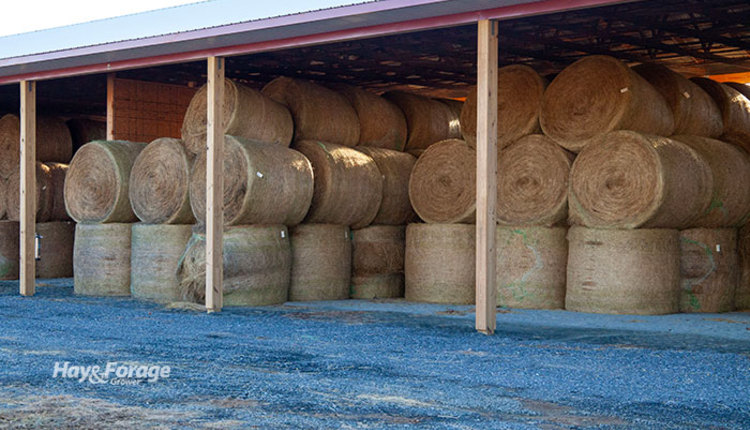
Enduring a drought is depleting for forages as well as farmers. Not only did the lack of rainfall through mid-summer limit yield and quality in hayfields across the country, but the dry weather has left producers to ponder how they will feed their livestock in the months ahead.
Buying bales might be an inevitable expense this fall and winter, but farmers can take steps to reduce the amount of hay they have to purchase. Michelle Sweeten with Michigan State University Extension notes hay yields across the Great Lakes State are projected to be 40% to 60% less in 2023 than in previous years; however, some of this shortage can be made up for with better bale storge and handling tactics.
“Before livestock farmers begin buying hay, they should look at their current storage system to determine if they can make changes to be better able to utilize the hay they already have,” the forage and livestock educator advises. “Properly made and stored round bales can minimize storage losses and maintain hay quality.”
The initial form of loss in hay bales occurs immediately after baling. If forage moisture is too high, respiration rates and microbial activity ramp up, causing heating and dry matter loss. This uptick in temperature can also lower forage quality as heating facilitates chemical reactions that bind sugars and amino acids into indigestible components, also known as Maillard products.
Once bale temperatures stabilize, forage yield and quality can still decline due to improper storage. Sweeten notes the most prominent factors impacting hay loss include the amount of moisture bales are exposed to, how long bales are exposed to moisture, and the air temperature during storage.
Keep bales covered
In general, uncovered bales that are stored outside are the most susceptible to hay loss. In fact, research from the University of Kentucky shows round bales tied with twine that are exposed to the elements can experience as much as 20% to 35% dry matter loss. Most of this loss occurs at the bottom of bales where moisture levels are high and air movement is low.
Selecting a well-drained storage site and/or using pallets, tires, crushed rock, or another porous material to create a layer between bales and the soil surface can help conserve dry matter loss when hay is stored outside. Better yet, wrapping round bales tied with twine in plastic, covering them with reusable tarps, or using bale sleeves can reduce dry matter loss even further.
Wrapping bales with plastic after baling can limit dry matter loss to about 4% to 7%. With that said, acquiring the equipment to do so comes at an added expense. Sweeten notes renting a baler equipped with an in-line bale wrapper costs about $14.65 per bale in her state. This number rises to about $18.59 per bale if baling and wrapping is hired out to a custom worker.
Applying net wrap at baling instead of tying hay with twine may be a cheaper solution to wrapping bales with plastic, but this won’t mitigate loss to the same extent. “Net wrapping makes the bale surface smoother and denser so it can shed water, but the advantage is not that significant,” Sweeten says. “Though some rain runs off the net-wrapped surface, enough soaks into the outer layer of the hay to cause deterioration.”
Covering outdoor bales with a plastic tarp may be more feasible for some farmers, and this method can also keep dry matter loss to 4% to 7% if bales are stored on a well-drained surface. To maximize the potential of plastic tarps, researchers from the University of Kentucky recommend stacking bales in a pyramid with three bales in the bottom layer, two bales in the second layer, and a single bale on the top. These tarps can be recycled for five to seven years.
Using bale sleeves is yet another approach to safeguarding forage yield and quality when bales are stored outside, but it is more labor intensive as they must be applied by hand. Bale sleeves also need to be sized correctly to ensure a tight fit, and they are not reusable. For these reasons, Sweeten suggests this practice is better suited for small quantities of round bales.
Store hay indoors
Overall, storing bales indoors is the best option to reduce hay loss. Although a new hay barn may come with hefty construction costs, Sweeten says the investment can pay for itself in the long run — especially when hay prices are high. University of Kentucky researchers estimate building a new hay barn can cost $2 to $4 per square foot of floor space. Considering depreciation, taxes, and other fees, they predict the annual expense of a permanent hay storage structure to be about $10 per ton of storage capacity.
Existing buildings like steel roof pole barns, wooden barns, and hoop barns can offer bales significant protection from weathering, and creating temporary storage structures will also be worth the time and labor to ensure hay is not subject to excess moisture.
“Any method of protection is better than leaving the bale outside exposed to the weather,” Sweeten asserts. “In a short hay year where all feeds will be priced high, covering what hay you already have is the most crucial step in determining ways to lessen the impact of lower yields.”

